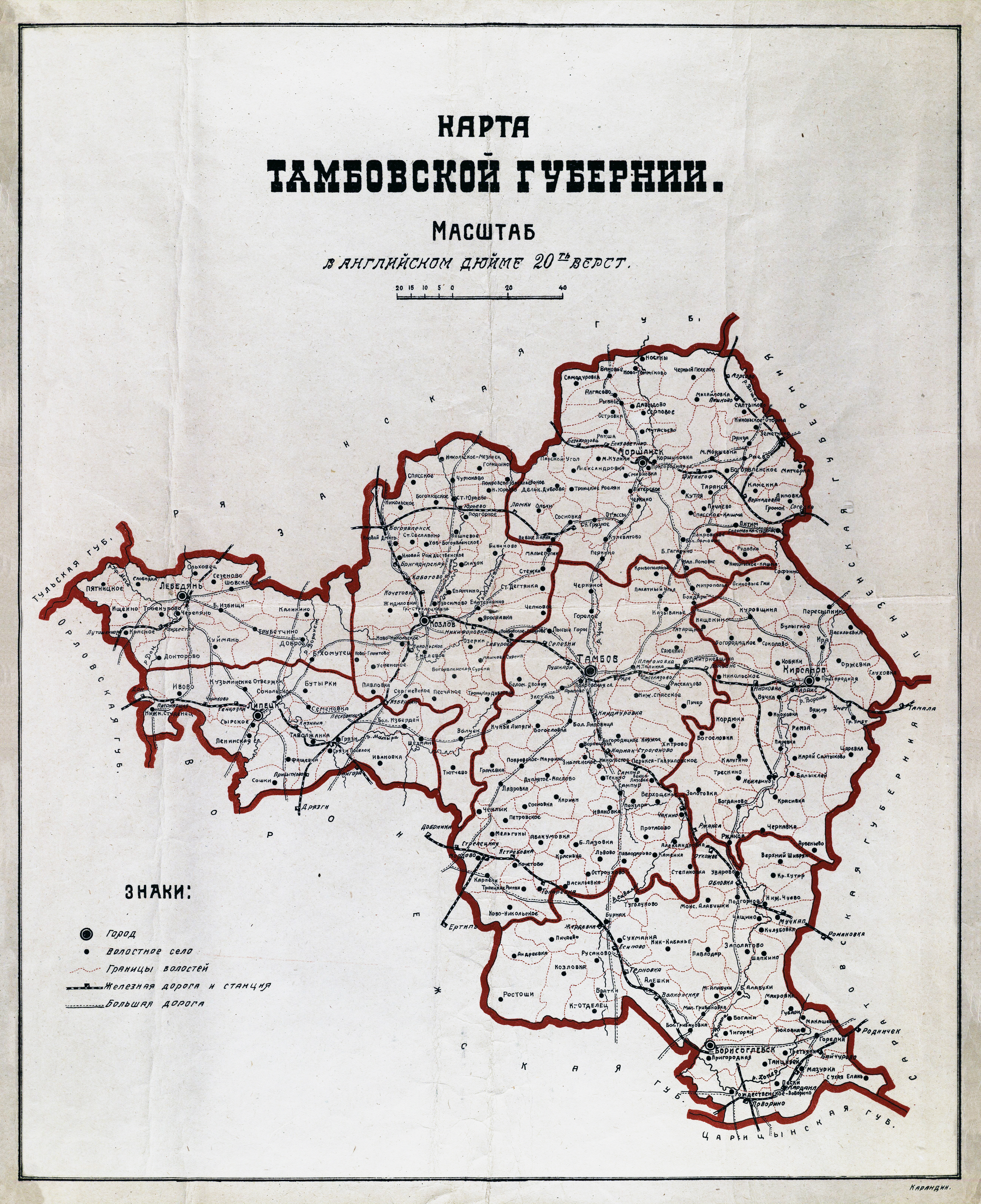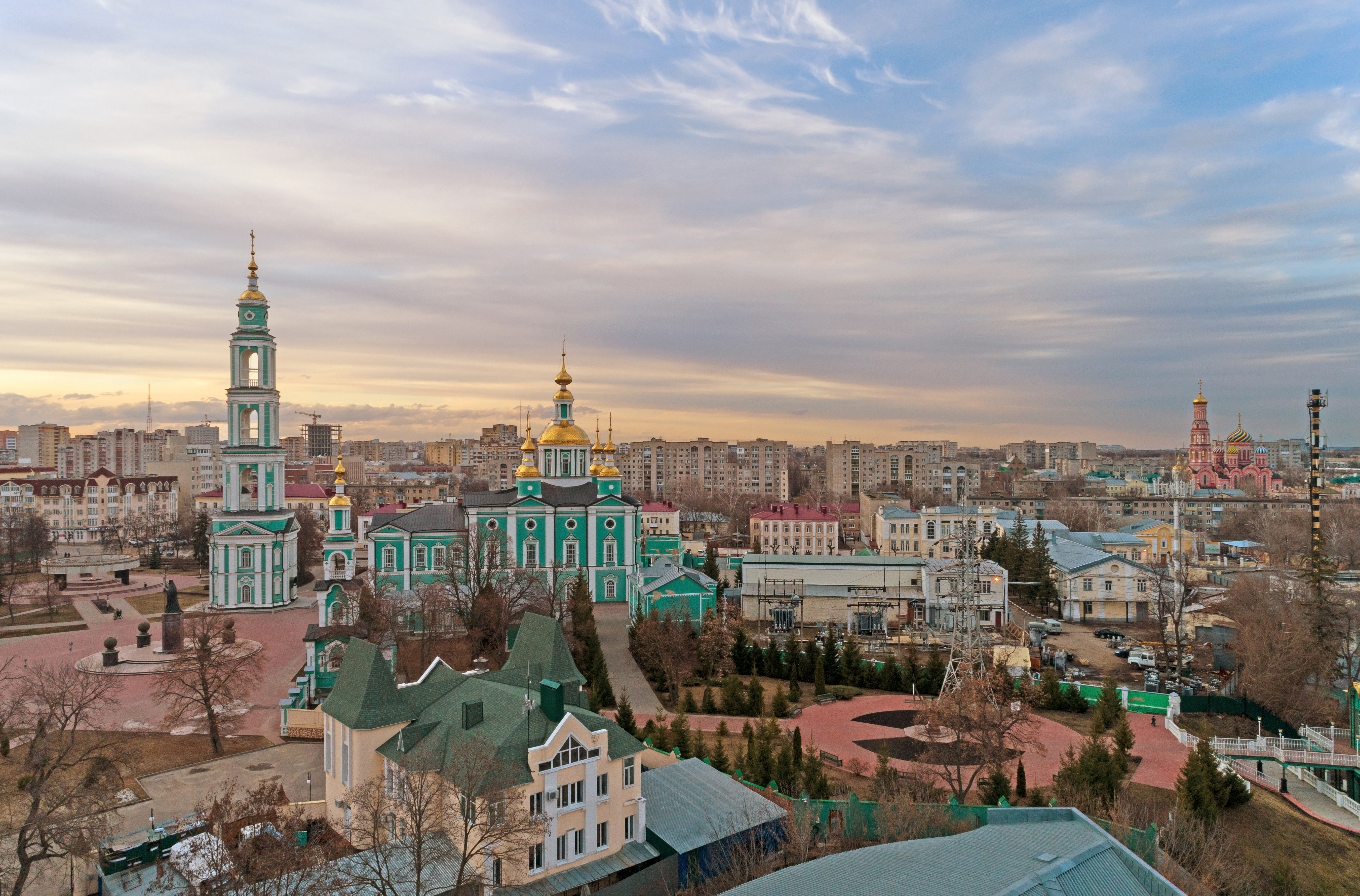|
Tambovsky Uyezd
Tambovsky Uyezd (''Тамбовский уезд'') was one of the subdivisions of the Tambov Governorate of the Russian Empire. It was situated in the central part of the governorate. Its administrative centre was Tambov. Demographics At the time of the Russian Empire Census of 1897, Tambovsky Uyezd had a population of 422,498. Of these, 99.2% spoke Russian, 0.3% Tatar, 0.2% Polish, 0.1% Ukrainian, 0.1% Yiddish and 0.1% German German(s) may refer to: * Germany, the country of the Germans and German things **Germania (Roman era) * Germans, citizens of Germany, people of German ancestry, or native speakers of the German language ** For citizenship in Germany, see also Ge ... as their native language. Демоскоп Weekly - Приложение. Справочник статистических показателей References ...
|
Tambov Governorate
Tambov Governorate () was an administrative-territorial unit (''guberniya'') of the Russian Empire, the Russian Republic, and the Russian SFSR, with its capital in Tambov. It was located between 51°14' and 55°6' north latitude, north and between 38°9' and 43°38' east longitude, east. It bordered Vladimir Governorate and Nizhny Novgorod Governorate to north, Penza Governorate and Saratov Governorate to the east, Voronezh Governorate to south and west, and Oryol Governorate, Tula Governorate, and Ryazan Governorate to the west. History The governorate was created in 1796 when it was reformed out of Tambov Viceroyalty (''namestnichestvo'') that was organized in 1779. The borders of it were unchanged until 1926 when the northern half of the governorate was split between other two governorates of Penza and Ryazan. Due to the administrative reform of 1928 Tambov governorate was divided into three okrugs: Tambov Okrug, Kozlov Okrug, and Borisoglebsk Okrug. In 1937 a substantial part ... [...More Info...] [...Related Items...] OR: [Wikipedia] [Google] [Baidu] |
Russian Empire
The Russian Empire was an empire that spanned most of northern Eurasia from its establishment in November 1721 until the proclamation of the Russian Republic in September 1917. At its height in the late 19th century, it covered about , roughly one-sixth of the world's landmass, making it the list of largest empires, third-largest empire in history, behind only the British Empire, British and Mongol Empire, Mongol empires. It also Russian colonization of North America, colonized Alaska between 1799 and 1867. The empire's 1897 census, the only one it conducted, found a population of 125.6 million with considerable ethnic, linguistic, religious, and socioeconomic diversity. From the 10th to 17th centuries, the Russians had been ruled by a noble class known as the boyars, above whom was the tsar, an absolute monarch. The groundwork of the Russian Empire was laid by Ivan III (), who greatly expanded his domain, established a centralized Russian national state, and secured inde ... [...More Info...] [...Related Items...] OR: [Wikipedia] [Google] [Baidu] |
Tambov
Tambov ( , ; rus, Тамбов, p=tɐmˈbof) is a types of inhabited localities in Russia, city and the administrative center of Tambov Oblast, Central Federal District, central Russia, at the confluence of the Tsna River (Moksha basin), Tsna and Studenets River, Studenets rivers, about south-southeast of Moscow. With a population of 261,803 as of 2021, Tambov is the largest city, and historical center, of the Tambov Oblast as a whole. Etymology The name "Tambov" originates from a Moksha language, Mokshan word (). Geography Urban layout In terms of its layout, Tambov was no different from other fortified cities – the Kremlin, the prison and a small settlement. The chosen place was in full compliance with the requirements of the fortification. From the north and east, the new fortress was washed by rivers, and from the west and south it was protected by artificial ditches filled with water by the Studenets River. The Kremlin was surrounded by a six-meter wooden wall with 12 ... [...More Info...] [...Related Items...] OR: [Wikipedia] [Google] [Baidu] |
Russian Language
Russian is an East Slavic languages, East Slavic language belonging to the Balto-Slavic languages, Balto-Slavic branch of the Indo-European languages, Indo-European language family. It is one of the four extant East Slavic languages, and is the native language of the Russians. It was the ''de facto'' and ''de jure'' De facto#National languages, official language of the former Soviet Union.1977 Soviet Constitution, Constitution and Fundamental Law of the Union of Soviet Socialist Republics, 1977: Section II, Chapter 6, Article 36 Russian has remained an official language of the Russia, Russian Federation, Belarus, Kazakhstan, Kyrgyzstan, and Tajikistan, and is still commonly used as a lingua franca in Ukraine, Moldova, the Caucasus, Central Asia, and to a lesser extent in the Baltic states and Russian language in Israel, Israel. Russian has over 253 million total speakers worldwide. It is the List of languages by number of speakers in Europe, most spoken native language in Eur ... [...More Info...] [...Related Items...] OR: [Wikipedia] [Google] [Baidu] |
Tatar Language
Tatar ( ; or ) is a Turkic languages, Turkic language spoken by the Volga Tatars mainly located in modern Tatarstan (European Russia), as well as Siberia. It should not be confused with Crimean Tatar language, Crimean Tatar or Siberian Tatar language, Siberian Tatar, which are closely related but belong to different subgroups of the Kipchak languages. Geographic distribution The Tatar language is spoken in Russia by about 5.3 million people, and also by communities in Azerbaijan, China, Finland, Georgia (country), Georgia, Israel, Kazakhstan, Latvia, Lithuania, Romania, Turkey, Ukraine, the United States, Uzbekistan, and several other countries. Globally, there are more than 7 million speakers of Tatar. Tatar is also the mother tongue for several thousand Mari people, Mari, a Finnic peoples, Finnic people; Mordva's Qaratay group also speak a variant of Kazan Tatar. In the Russian Census (2010), 2010 census, 69% of Russian Tatars claimed at least some knowledge of the ... [...More Info...] [...Related Items...] OR: [Wikipedia] [Google] [Baidu] |
Polish Language
Polish (, , or simply , ) is a West Slavic languages, West Slavic language of the Lechitic languages, Lechitic subgroup, within the Indo-European languages, Indo-European language family, and is written in the Latin script. It is primarily spoken in Poland and serves as the official language of the country, as well as the language of the Polish diaspora around the world. In 2024, there were over 39.7 million Polish native speakers. It ranks as the sixth-most-spoken among languages of the European Union. Polish is subdivided into regional Dialects of Polish, dialects. It maintains strict T–V distinction pronouns, Honorifics (linguistics), honorifics, and various forms of formalities when addressing individuals. The traditional 32-letter Polish alphabet has nine additions (, , , , , , , , ) to the letters of the basic 26-letter Latin alphabet, while removing three (x, q, v). Those three letters are at times included in an extended 35-letter alphabet. The traditional set compri ... [...More Info...] [...Related Items...] OR: [Wikipedia] [Google] [Baidu] |
Ukrainian Language
Ukrainian (, ) is an East Slavic languages, East Slavic language, spoken primarily in Ukraine. It is the first language, first (native) language of a large majority of Ukrainians. Written Ukrainian uses the Ukrainian alphabet, a variant of the Cyrillic script. The standard language is studied by the National Academy of Sciences of Ukraine and Potebnia Institute of Linguistics. Comparisons are often made between Ukrainian and Russian language, Russian, another East Slavic language, yet there is more mutual intelligibility with Belarusian language, Belarusian,Alexander M. Schenker. 1993. "Proto-Slavonic", ''The Slavonic Languages''. (Routledge). pp. 60–121. p. 60: "[The] distinction between dialect and language being blurred, there can be no unanimity on this issue in all instances..."C.F. Voegelin and F.M. Voegelin. 1977. ''Classification and Index of the World's Languages'' (Elsevier). p. 311, "In terms of immediate mutual intelligibility, the East Slavic zone is a sin ... [...More Info...] [...Related Items...] OR: [Wikipedia] [Google] [Baidu] |
Yiddish
Yiddish, historically Judeo-German, is a West Germanic language historically spoken by Ashkenazi Jews. It originated in 9th-century Central Europe, and provided the nascent Ashkenazi community with a vernacular based on High German fused with many elements taken from Hebrew language, Hebrew (notably Mishnaic Hebrew, Mishnaic) and to some extent Aramaic. Most varieties of Yiddish include elements of Slavic languages and the vocabulary contains traces of Romance languages.Aram Yardumian"A Tale of Two Hypotheses: Genetics and the Ethnogenesis of Ashkenazi Jewry".University of Pennsylvania. 2013. Yiddish has traditionally been written using the Hebrew alphabet. Prior to World War II, there were 11–13 million speakers. 85% of the approximately 6 million Jews who were murdered in the Holocaust were Yiddish speakers,Solomon Birnbaum, ''Grammatik der jiddischen Sprache'' (4., erg. Aufl., Hamburg: Buske, 1984), p. 3. leading to a massive decline in the use of the language. Jewish ass ... [...More Info...] [...Related Items...] OR: [Wikipedia] [Google] [Baidu] |
German Language
German (, ) is a West Germanic language in the Indo-European language family, mainly spoken in Western Europe, Western and Central Europe. It is the majority and Official language, official (or co-official) language in Germany, Austria, Switzerland, and Liechtenstein. It is also an official language of Luxembourg, German-speaking Community of Belgium, Belgium and the Italian autonomous province of South Tyrol, as well as a recognized national language in Namibia. There are also notable German-speaking communities in other parts of Europe, including: Poland (Upper Silesia), the Czech Republic (North Bohemia), Denmark (South Jutland County, North Schleswig), Slovakia (Krahule), Germans of Romania, Romania, Hungary (Sopron), and France (European Collectivity of Alsace, Alsace). Overseas, sizeable communities of German-speakers are found in the Americas. German is one of the global language system, major languages of the world, with nearly 80 million native speakers and over 130 mi ... [...More Info...] [...Related Items...] OR: [Wikipedia] [Google] [Baidu] |
Tambovsky Uyezd
Tambovsky Uyezd (''Тамбовский уезд'') was one of the subdivisions of the Tambov Governorate of the Russian Empire. It was situated in the central part of the governorate. Its administrative centre was Tambov. Demographics At the time of the Russian Empire Census of 1897, Tambovsky Uyezd had a population of 422,498. Of these, 99.2% spoke Russian, 0.3% Tatar, 0.2% Polish, 0.1% Ukrainian, 0.1% Yiddish and 0.1% German German(s) may refer to: * Germany, the country of the Germans and German things **Germania (Roman era) * Germans, citizens of Germany, people of German ancestry, or native speakers of the German language ** For citizenship in Germany, see also Ge ... as their native language. Демоскоп Weekly - Приложение. Справочник статистических показателей References ...
|
Uezds Of Tambov Governorate
An uezd (also spelled uyezd or uiezd; rus, уе́зд ( pre-1918: уѣздъ), p=ʊˈjest), or povit in a Ukrainian context () was a type of administrative subdivision of the Grand Duchy of Moscow, the Tsardom of Russia, the Russian Empire, the Russian SFSR, and the early Soviet Union, which was in use from the 13th century. For most of Russian history, uezds were a second-level administrative division. By sense, but not by etymology, ''uezd'' approximately corresponds to the English "county". General description Originally describing groups of several volosts, they formed around the most important cities. Uezds were ruled by the appointees (''namestniki'') of a knyaz and, starting from the 17th century, by voyevodas. In 1708, an administrative reform was carried out by Peter the Great, dividing Russia into governorates. The subdivision into uyezds was abolished at that time but was reinstated in 1727, as a result of Catherine I's administrative reform. By the USSR administra ... [...More Info...] [...Related Items...] OR: [Wikipedia] [Google] [Baidu] |




